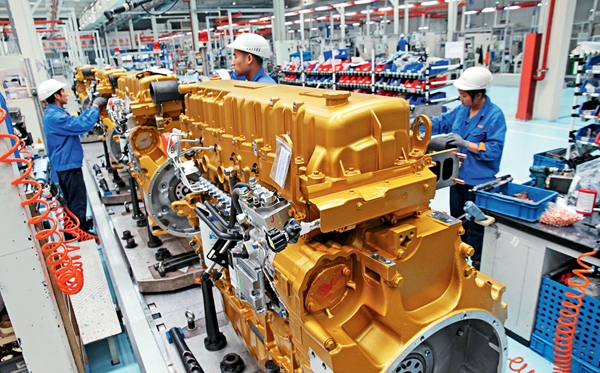A rising innovation-oriented country
- By Xiong Hongru
 0 Comment(s)
0 Comment(s) Print
Print E-mail China Today, April 7, 2017
E-mail China Today, April 7, 2017
|
|
|
Workers with Y&C Engine Co., Ltd. in Wuhu City of Anhui Province install on November 2, 2016, their independently developed engine, which features lower fuel consumption and lower emissions. [Photo/China Today] |
China's economic development and reforms to its economic system have made great strides in the almost four decades since the reform and opening-up policy came into effect. The country has also witnessed the transformation of its economic development model and allocation of resources, as well as progress in its science and technology, and industrial structure. Most notable is how innovation has become the driving force of China's economic growth, thus signifying its rise as an innovative nation. Innovation is indeed the primary force behind China's new round of economic growth, structural adjustment, and industrial transformation and upgrade. The experience China gained over the past decades amid efforts to forge its innovation capabilities has helped to achieve the country's leapfrog development, and also generated considerable influence globally.
Innovation – New Impetus for Economic Growth
China's innovation-driven development has entered the new historical stage whereby its people are more enthusiastic than ever about innovation.
China has honed its innovation capabilities in the process of economic catch-up. Having started out by copying foreign apparatus and later introducing and eventually absorbing advanced technologies, China's native expertise is now capable of independent research and development (R&D). Its first innovative steps were apparent in technology, product design, and manufacturing technique. It has since progressed to innovative management, organization, and business models. Longstanding R&D input and accumulation has built a solid foundation for China's rise to a large, technologically advanced nation. However, the focus of China's upgraded innovation capabilities is now on quality rather than quantity.
China stands at the world forefront of innovative input and output. Since 2000, China's R&D investment growth has outstripped that of its GDP. Currently, China's R&D spending accounts for about 20 percent of the global total, giving it a world second ranking. In 2016, China's R&D investment accounted for 2.1 percent of GDP, so securing a first ranking among developing countries. Numbers of China's R&D personnel constitute around 30 percent of the global total – making it first in the world. In addition, the gap between the amount of international patent applications from China and from developed countries has narrowed. China now holds third place in this regard. China is also the source of about 15 percent of the global total number of Science Citation Index (SCI) papers, so giving it a second global ranking in this respect. The Global Innovation Index 2016 released by the World Intellectual Property Organization ranked China 25th in innovation capabilities, so surpassing certain high-income economies. Meanwhile, China's manufacturing is steadily moving from the low end to the middle and high end of the value chain. Certain of its giant enterprises wield significant clout on the global market. China has moreover made breakthroughs in key technologies. It leads the world in mobile communications, manned space flights, satellite applications, high speed railways, ultra-high voltage grids, supercomputing, quantum communication, and mobile Internet.
Chinese enterprises have become more proactive in their innovations. This is apparent in growing R&D investment and the dwindling proportion of introduced technology. Enterprise investment accounts for over 75 percent of national R&D spending. More than 70 percent of the country's total R&D personnel are enterprise employees. A new batch of innovative enterprises intent on participating in international competition has also appeared. The first National Bureau of Statistics (NBS) survey in 2015 on the innovative activities of Chinese enterprises showed that, in the period 2013 to 2014, about 266,000 enterprises out of the total 646,000 enterprises surveyed – a 41.3 percent proportion – pursued innovative activities. Taking industrial enterprises as an example, their proportion in this respect has grown from the 28.8 percent of a decade ago to 46.8 percent. The main focus of Chinese enterprises is on improving management efficiency and stepping up innovations of business models; around 27.9 percent have carried out organizational innovation and 25.8 percent marketing innovation. Moreover, Chinese entrepreneurs are young, well-educated, and keen to innovate.
China's innovation and entrepreneurship environment has steadily improved. Since the reform and opening-up policy came into force the Chinese government has formulated successive policies to promote scientific and technological progress. It also integrated R&D and economic development to suit the characteristics of different periods. The year 1980 saw the launch of reform to the scientific and technological system. In the 1990s, the central government put forward the strategy of Reinvigorating the Country through Science and Education. In 2006 it proposed, in the guidelines of the National Medium- and Long-term Program for Science and Technology Development (2006-2020), construction of the country's innovation system. Since 2012, it has encouraged innovation-driven development and deepened reforms to the scientific and technological system. In 2016, it released the Outline of the National Strategy of Innovation-Driven Development. All these policies and measures constitute a relatively complete policy system to support innovation. In recent years, the government has switched its focus – from improving the system, to encouraging innovation activities, to building a favorable environment wherein market players take the initiative to make innovations and let the market play its role.
The government now strives to make policies that bring benefits for all, and issues supporting policies that address market players' every possible concern.
The new power to boost China's economic development has formed amid the country's honing of its R&D capability, optimizing resource allocation, raising efficiency, and improving the innovation environment.







Go to Forum >>0 Comment(s)